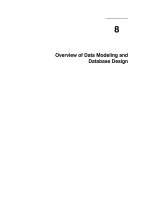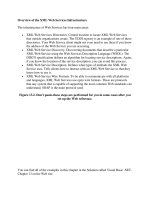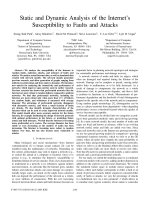Overview of the PSTN and Comparisons to voice over IP
Bạn đang xem bản rút gọn của tài liệu. Xem và tải ngay bản đầy đủ của tài liệu tại đây (507.16 KB, 23 trang )
Chapter 1. Overview of the PSTN and Comparisons to
Voice over IP
The Public Switched Telephone Network (PSTN) has been evolving ever since Alexander Graham Bell made
the first voice transmission over wire in 1876. But, before explaining the present state of the PSTN and what's
in store for the future, it is important that you understand PSTN history and it's basics. As such, this chapter
discusses the beginnings of the PSTN and explains why the PSTN exists in its current state.
This chapter also covers PSTN basics, components, and services to give you a good introduction to how the
PSTN operates today. Finally, it discusses where the PSTN could be improved and ways in which it and other
voice networks are evolving to the point at which they combine data, video, and voice.
The Beginning of the PSTN
The first voice transmission, sent by Alexander Graham Bell, was accomplished in 1876 through what is called
a ring-down circuit. A ring-down circuit means that there was no dialing of numbers, Instead, a physical wire
connected two devices. Basically, one person picked up the phone and another person was on the other end
(no ringing was involved).
Over time, this simple design evolved from a one-way voice transmission, by which only one user could speak,
to a bi-directional voice transmission, whereby both users could speak. Moving the voices across the wire
required a carbon microphone, a battery, an electromagnet, and an iron diaphragm.
It also required a physical cable between each location that the user wanted to call. The concept of dialing a
number to reach a destination, however, did not exist at this time.
To further illustrate the beginnings of the PSTN, see the basic four-telephone network shown in Figure 1-1
.
As you can see, a physical cable exists between each location.
Figure 1-1. Basic Four-Phone Network
Place a physical cable between every household requiring access to a telephone, however, and you'll see that
such a setup is neither cost-effective nor feasible (see Figure 1-2
). To determine how many lines you need to
11
your house, think about everyone you call as a value of N and use the following equation: N × (N–1)/2. As
such, if you want to call 10 people, you need 45 pairs of lines running into your house.
Figure 1-2. Physical Cable Between All Telephone Users
Due to the cost concerns and the impossibility of running a physical cable between everyone on Earth who
wanted access to a telephone, another mechanism was developed that could map any phone to another
phone. With this device, called a switch , the telephone users needed only one cable to the centralized switch
office, instead of seven.
At first, a telephone operator acted as the switch. This operator asked callers where they wanted to dial and
then manually connected the two voice paths. Figure 1-3
shows how the four-phone network example would
look today with a centralized operator to switch the calls.
12
Figure 1-3. Centralized Operator: The Human Switch
Now, skip ahead 100 years or so—the human switch is replaced by electronic switches. At this point, you can
learn how the modern PSTN network is built.
Understanding PSTN Basics
Although it is difficult to explain every component of the PSTN, this section explains the most important pieces
that make the PSTN work. The following sections discuss how your voice is transmitted across a digital
network, basic circuit-switching concepts, and why your phone number is 10 digits long.
Analog and Digital Signaling
Everything you hear, including human speech, is in analog form. Until several decades ago, the telephony
network was based on an analog infrastructure as well.
Although analog communication is ideal for human interaction, it is neither robust nor efficient at recovering
from line noise. (Line noise is normally caused by the introduction of static into a voice network.) In the early
telephony network, analog transmission was passed through amplifiers to boost the signal. But, this practice
amplified not just the voice, but the line noise as well. This line noise resulted in an often unusable connection.
Analog communication is a mix of time and amplitude. Figure 1-4
, which takes a high-level view of an analog
waveform, shows what your voice looks like through an oscilloscope.
13
Figure 1-4. Analog Waveform
If you were far away from the end office switch (which provides the physical cable to your home), an amplifier
might be required to boost the analog transmission (your voice). Analog signals that receive line noise can
distort the analog waveform and cause garbled reception. This is more obvious to the listener if many
amplifiers are located between your home and the end office switch. Figure 1-5
shows that an amplifier does
not clean the signal as it amplifies, but simply amplifies the distorted signal. This process of going through
several amplifiers with one voice signal is called accumulated noise .
Figure 1-5. Analog Line Distortion
In digital networks, line noise is less of an issue because repeaters not only amplify the signal, but clean it to
its original condition. This is possible with digital communication because such communication is based on 1s
and 0s. So, as shown in Figure 1-6
, the repeater (a digital amplifier) only has to decide whether to regenerate
a 1 or a 0.
14
Figure 1-6. Digital Line Distortion
Therefore, when signals are repeated, a clean sound is maintained. When the benefits of this digital
representation became evident, the telephony network migrated to pulse code modulation (PCM).
Digital Voice Signals
PCM is the most common method of encoding an analog voice signal into a digital stream of 1s and 0s. All
sampling techniques use the Nyquist theorem , which basically states that if you sample at twice the highest
frequency on a voice line, you achieve good-quality voice transmission.
The PCM process is as follows:
• Analog waveforms are put through a voice frequency filter to filter out anything greater than 4000 Hz.
These frequencies are filtered to 4000 Hz to limit the amount of crosstalk in the voice network. Using
the Nyquist theorem, you need to sample at 8000 samples per second to achieve good-quality voice
transmission.
• The filtered analog signal is then sampled at a rate of 8000 times per second.
• After the waveform is sampled, it is converted into a discrete digital form. This sample is represented
by a code that indicates the amplitude of the waveform at the instant the sample was taken. The
telephony form of PCM uses eight bits for the code and a logarithm compression method that assigns
more bits to lower-amplitude signals.
If you multiply the eight-bit words by 8000 times per second, you get 64,000 bits per second (bps). The basis
for the telephone infrastructure is 64,000 bps (or 64 kbps).
Two basic variations of 64 kbps PCM are commonly used: µ-law, the standard used in North America; and a-
law, the standard used in Europe. The methods are similar in that both use logarithmic compression to achieve
from 12 to 13 bits of linear PCM quality in only eight-bit words, but they differ in relatively minor details. The µ-
law method has a slight advantage over the a-law method in terms of low-level signal-to-noise ratio
performance, for instance.
NOTE
When making a long-distance call, any µ-law to a-law conversion is the responsibility of the µ-law
country.
15
Local Loops, Trunks, and Interswitch Communication
The telephone infrastructure starts with a simple pair of copper wires running to your home. This physical
cabling is known as a local loop . The local loop physically connects your home telephone to the central office
switch (also known as a Class 5 switch or end office switch ). The communication path between the central
office switch and your home is known as the phone line, and it normally runs over the local loop.
The communication path between several central office switches is known as a trunk . Just as it is not cost-
effective to place a physical wire between your house and every other house you want to call, it is also not
cost-effective to place a physical wire between every central office switch. You can see in Figure 1-7
that a
meshed telephone network is not as scalable as one with a hierarchy of switches.
16
Figure 1-7. Meshed Network Versus Hierarchical Network
Switches are currently deployed in hierarchies. End office switches (or central office switches) interconnect
through trunks to tandem switches (also referred to as Class 4 switches). Higher-layer tandem switches
connect local tandem switches. Figure 1-8
shows a typical model of switching hierarchy.
17
Figure 1-8. Circuit-Switching Hierarchy
Central office switches often directly connect to each other. Where the direct connections occur between
central office switches depends to a great extent on call patterns. If enough traffic occurs between two central
office switches, a dedicated circuit is placed between the two switches to offload those calls from the local
tandem switches. Some portions of the PSTN use as many as five levels of switching hierarchy.
Now that you know how and why the PSTN is broken into a hierarchy of switches, you need to understand
how they are physically connected, and how the network communicates.
PSTN Signaling
Generally, two types of signaling methods run over various transmission media. The signaling methods are
broken into the following groups:
• User-to-network signaling—
This is how an end user communicates with the PSTN.
• Network-to-network signaling—
This is generally how the switches in the PSTN intercommunicate.
User-to-Network Signaling
Generally, when using twisted copper pair as the transport, a user connects to the PSTN through analog,
Integrated Services Digital Network (ISDN), or through a T1 carrier.
The most common signaling method for user-to-network analog communication is Dual Tone Multi-Frequency
(DTMF) . DTMF is known as in-band signaling because the tones are carried through the voice path. Figure
1-9 shows how DTMF tones are derived.
18
Figure 1-9. Dual Tone Multi-Frequency
When you pick up your telephone handset and press the digits (as shown in Figure 1-9
), the tone that passes
from your phone to the central office switch to which you are connected tells the switch what number you want
to call.
ISDN uses another method of signaling known as out-of-band . With this method, the signaling is transported
on a channel separate from the voice. The channel on which the voice is carried is called a bearer (or B
channel) and is 64 kbps. The channel on which the signal is carried is called a data channel (D channel) and is
16 kbps. Figure 1-10
shows a Basic Rate Interface (BRI) that consists of two B channels and one D channel.
Figure 1-10. Basic Rate Interface
Out-of-band signaling offers many benefits, including the following:
• Signaling is multiplexed (consolidated) into a common channel.
• Glare is reduced (glare occurs when two people on the same circuit seize opposite ends of that circuit
at the same time).
• A lower post dialing delay.
• Additional features, such as higher bandwidth, are realized.
• Because setup messages are not subject to the same line noise as DTMF tones, call completion is
greatly increased.
19









